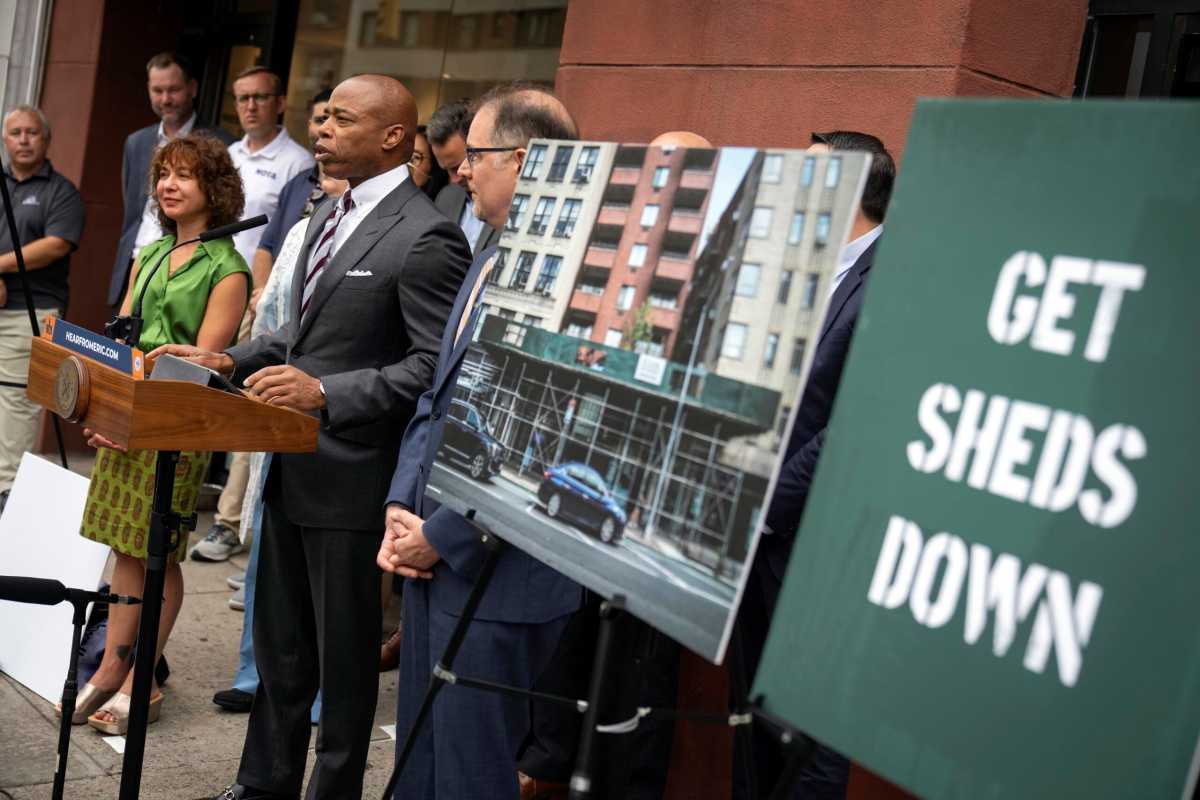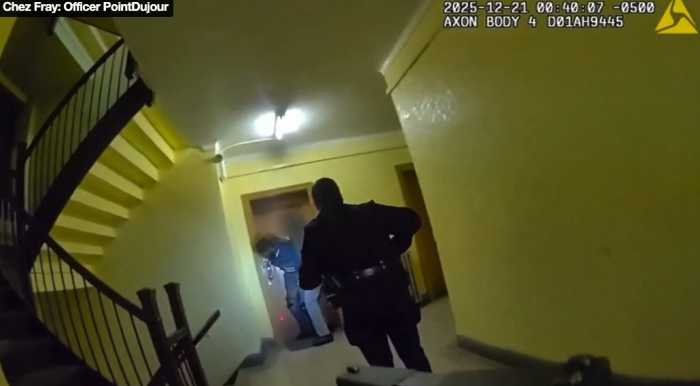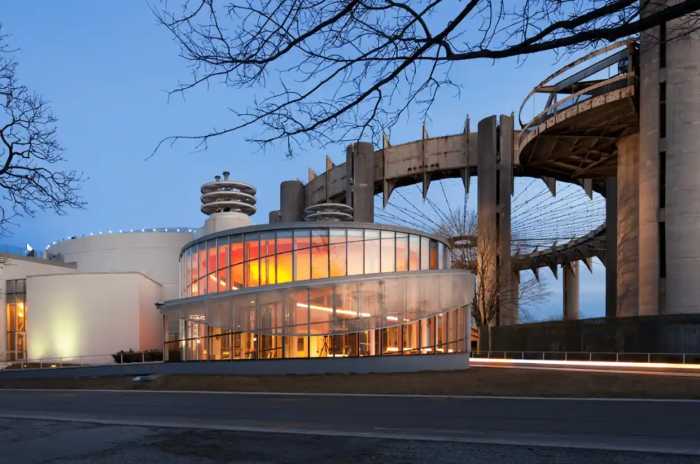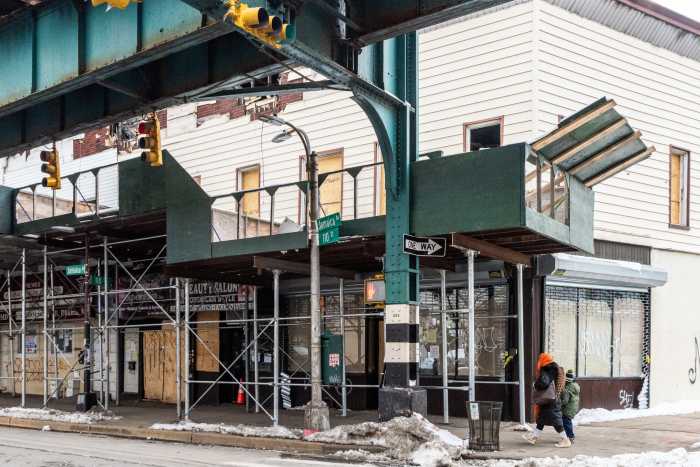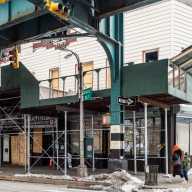For more than half a decade, unsightly sidewalk construction shed and scaffolding have created an eyesore around the Queens County Supreme Court building on Sutphin Boulevard in Jamaica. On Monday, Mayor Eric Adams announced a pilot that will remove the structure and replace it with safety netting as part of his new “Get Sheds Down” initiative, a sweeping overhaul of rules governing construction sheds that are a blight on public spaces.
“Look at the Supreme Court building in Queens County,” Adams said. “We are going to run a pilot and use netting. That shed has been up for six years. So don’t let anyone make you believe, we must make the forced choice between safety and scenery. We could have them both. For too long, bureaucratic rules have stood in the way of progress, but today, we are turning the page and overhauling these rules from the ground up with our ‘Get Sheds Down’ plan. This plan will flip the script so that property owners are incentivized to complete safety work and remove sheds instead of leaving up these eyesores year after year. This is how we reimagine our city, revitalize our business districts, and build a safer, more welcoming city for all.”
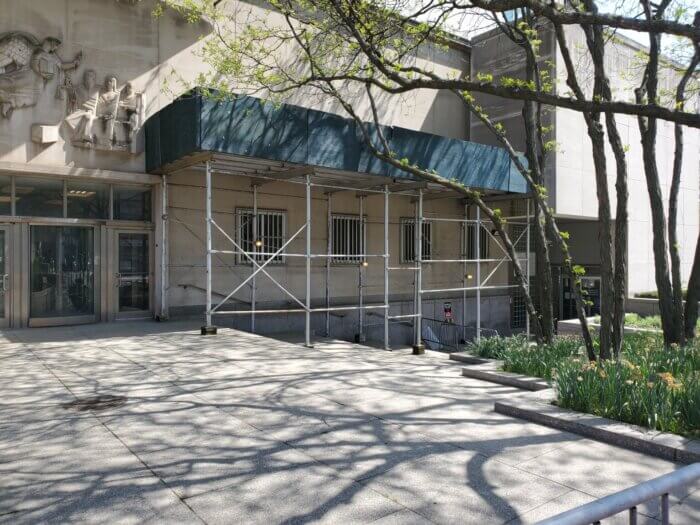
Administrative Judge Margurite Grays of the Queens County Supreme Court, Civil Term, welcomed the news.
“Many thanks to Mayor Adams for his leadership in taking action on the removal of the sidewalk sheds,” she said. “The sidewalk sheds have hidden the beauty of this historic Courthouse and have been a long-standing concern.
Lucian Chalfen, the New York State Office of Court Administration’s director of public information, welcomed the mayor’s announcement.
“Any improvement that will address and alleviate the shed situation is welcome news,” Chalfen said.
The city Department of Buildings will post an official agency Buildings Bulletin at the courthouse with specific rules governing the use of safety containment netting as an approved form of pedestrian protection that can, in certain circumstances, be used in place of a traditional sidewalk shed. Façade safety netting is currently allowed in the city but rarely used, in part because of the absence of a standardized design that can be easily replicated.
The city Department of Citywide Administrative Services, which operates the courthouse, will pilot the use of netting to partially replace a pre-existing shed in front of Queens County Supreme Court. Once the bulletin is posted, any city agency that owns a building or is sponsoring a construction project requiring pedestrian protection will be required to assess whether netting can be used. Only if netting is ruled out as a viable option will the agency be able to proceed with the implementation of a traditional shed.
“The Department of Buildings is excited to work with our partners at DCAS as they work to implement netting as an alternative to the traditional shed that exists at the Queens County Courthouse now,” DOB Commissioner Jimmy Oddo said. “Our agency and the wider administration is always looking for creative solutions in our efforts to Get Stuff Done, and hopefully we’ll be able to expand on the netting pilot program at City-owned buildings for the benefit of more New Yorkers.”
Queens elected officials applauded the initiative and look forward to its expansion following the pilot at the Queens Supreme Court building.
“These sheds have not only been eyesores for years, but they have also served as hotbeds for criminal activity as well,” Councilwoman Joann Ariola said. “How many New Yorkers have had to feel uncomfortable walking through these darkened sheds late at night, wondering if a criminal were laying in wait for them? Fortunately, those fears, and the blight that these sheds cause to the aesthetic appeal of our city, will become a thing of the past thanks to this new program. I am glad to see these steps being taken, as they will undoubtedly contribute to the enhancement of public safety in the five boroughs.”
Councilwoman Sandra Ung said the program will be well-received in downtown Flushing.
“In my district, construction sheds and scaffolding are not only a blight on the community, they also become a haven for illegal activity,” Ung said. “And in a busy commercial area like downtown Flushing, the sheds impede pedestrian flow and add to our already congested sidewalks. I am happy the city is focused on creating a less-intrusive alternative that will continue to ensure safety around construction sites, while also improving the quality of life for residents across our city.”
Councilman Robert Holden said the city has suffered from the unsightly presence of scaffolds and sheds for far too long.
“But this policy marks a positive stride towards eliminating this visual blight,” he said. “However, we must not stop here; extending the policy to encompass construction sites, green fences, and other building materials stores in public view would further enhance our efforts in beautifying our cityscape.”
Assemblywoman Jenifer Rajkumar echoed that sentiment.
“Mayor Adams and DOB Commissioner Oddo will remove the sidewalk sheds, also known as scaffolding, so we can see the full beauty of the city streets and landscape,” Rajkumar said. “We will reimagine shed design and regulations while ensuring that there is no compromise to our safety. Sheds will be unintrusive, aesthetically pleasing, and — best of all — short-lived. That translates to more sunlight and increased foot traffic to street-level businesses. It also means fewer spots for bad apples to congregate and less space for pigeons to perch. This plan will reclaim our streets from the nearly 10,000 sidewalk sheds hiding the charm of our city.”
The program will begin in Midtown Manhattan, Downtown Brooklyn, the Grand Concourse in the Bronx and Long Island City.
“The Long Island City Partnership applauds Mayor Adams and the Department of Buildings for their proposed sidewalk shed reforms,” LICP President Laura Rothrock said. “Safety is always the number one priority, but improving the sidewalk shed regulations will open up the streetscape and create a more welcoming public realm.”

